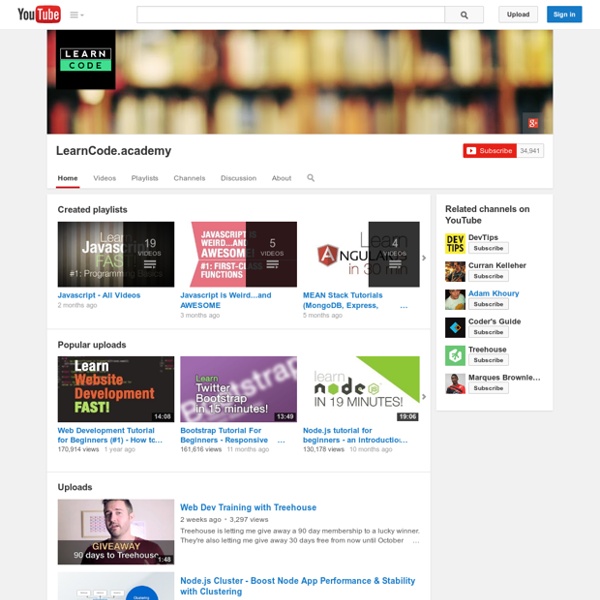



NumericAndScientific/Plotting Over the years many different plotting modules and packages have been developed for Python. For most of that time there was no clear favorite package, but recently matplotlib has become the most widely used. Nevertheless, many of the others are still available and may suit your tastes or needs better. Some of these are interfaces to existing plotting libraries while others are Python-centered new implementations. Matplotlib is an Open Source plotting library designed to support interactive and publication quality plotting with a syntax familiar to Matlab users.
CoderDojo CoderDojo logo CoderDojo is a global network of clubs that teach young people in areas specializing in computer programming and computer technology. There are now clubs in 22 countries,[1][2] teaching 10,000 children to write computer code and programs each week.[3] Youth learn from one another about computer languages and tools including Xcode and CSS.[4] Origin and growth[edit] In addition to teaching, they hope to allow children who know how to code to meet others with similar interests and work on projects with their peers around them, similar to how a co-working space[clarification needed] works, but less formal. References[edit] External links[edit]
Learn JavaScript Online - Courses for Beginners - javascript.com Lucid dreaming academy | Lucidipedia.com Problems | Locations Rosalind is a platform for learning bioinformatics and programming through problem solving. Take a tour to get the hang of how Rosalind works. If you don't know anything about programming, you can start at the Python Village. For a collection of exercises to accompany Bioinformatics Algorithms book, go to the Textbook Track. Otherwise you can try to storm the Bioinformatics Stronghold right now. If you are completely new to programming, try these initial problems to learn a few basics about the Python programming language. Bioinformatics Stronghold Discover the algorithms underlying a variety of bioinformatics topics: computational mass spectrometry, alignment, dynamic programming, genome assembly, genome rearrangements, phylogeny, probability, string algorithms and others. Ready-to-use software tools abound for bioinformatics analysis. Bioinformatics Textbook Track
Jean Michel Billaut NodeSchool Kung Fu Typing This is keybr.com, a web application that will help you teach touch typing. Touch typing is typing without using the sense of sight to find the keys. A person possessing touch typing skills will know their location on the keyboard through muscle memory. This is a short tutorial that will explain how does this application work. You can use the left and right arrow keys to navigate through these slides. This tutorial is based on these few principles: No boring, repetitive exercises. Initially it starts generating words from a small subset of the most frequent letters of the alphabet. When you are typing these words, keybr measures time to type a key for every letter in that subset. Once you familiarize yourself with the current subset of letters, the algorithm expands it, including more and more letters to it. The algorithm can also artificially rearrange letter frequencies, putting emphasis on the letters with the worst time to type measure. This is the text board. This is virtual keyboard.
UNIX / Linux Tutorial for Beginners A beginners guide to the Unix and Linux operating system. Eight simple tutorials which cover the basics of UNIX / Linux commands. Introduction to the UNIX Operating System What is UNIX? Recommended UNIX and Linux books If you wish to continue learning Unix, here is a list of good Unix and Linux books, ranging from beginners to advanced.
Site du Zéro Un article de Wikipédia, l'encyclopédie libre. OpenClassrooms (anciennement le Site du Zéro), est un site web qui propose des tutoriels sur l'informatique et sur les sciences. Les cours en ligne, qu'ils soient écrits par l'équipe du site ou ses membres, demandent généralement assez peu de connaissances préalables. Historique[modifier | modifier le code] Le site a été créé sous le nom de « Site du Zéro » en 1999 par Mathieu Nebra[SdZ 3], alors âgé de 13 ans[SdZ 4], sous le pseudonyme de M@teo21. C'est durant cette version que le Site du Zéro se fait connaître, d'où la nécessité[SdZ 2] de réécrire le code source du site, celui-ci étant devenu ingérable. Depuis la deuxième version — les critères d'acceptation des tutoriels ayant été revus à la hausse après le passage à la version 3 —, il est devenu possible, pour les membres, de proposer des tutoriels afin de compléter la base de connaissances du site. Le , un second site ouvre ses portes[SdZ 10], cette fois-ci consacré aux sciences.
Expert led courses for front-end web developers. | egghead.io DirSense - Infinite Impression git/github guide All statistical/computational scientists should use git and github, but it can be hard to get started. I hope these pages help. (More blather below.) There are many resources for git and github; my aim is to provide the minimal guide to get started. I love git and github. I use both for keeping track of programming projects, papers, talks, and data analyses. I use git mostly from the command line on a Mac. I would like all of my statistical/computational collaborators to use git and github, so that we may collaborate more easily. Saunak Sen got me started with version control (using subversion), and Pjotr Prins got me to move from subversion to git, but don’t hold either responsible for any errors in my understanding. If you have suggestions for changes or improvements, submit an issue or fork the repo: Follow the instructions above, “Contribute to someone’s repository.”